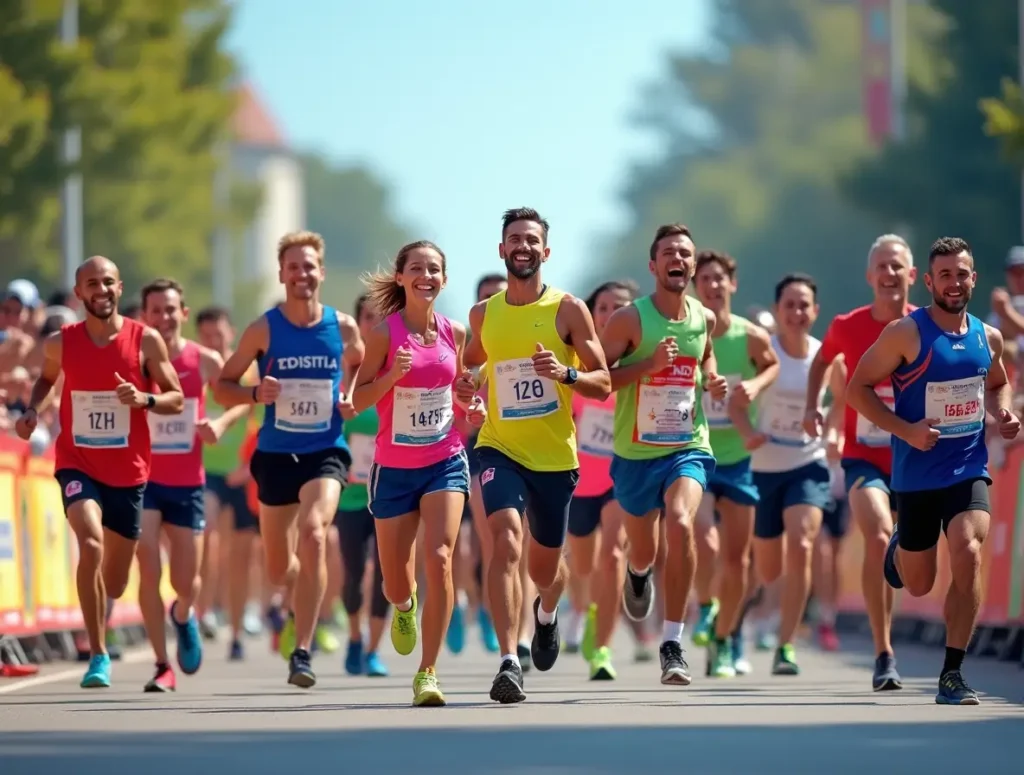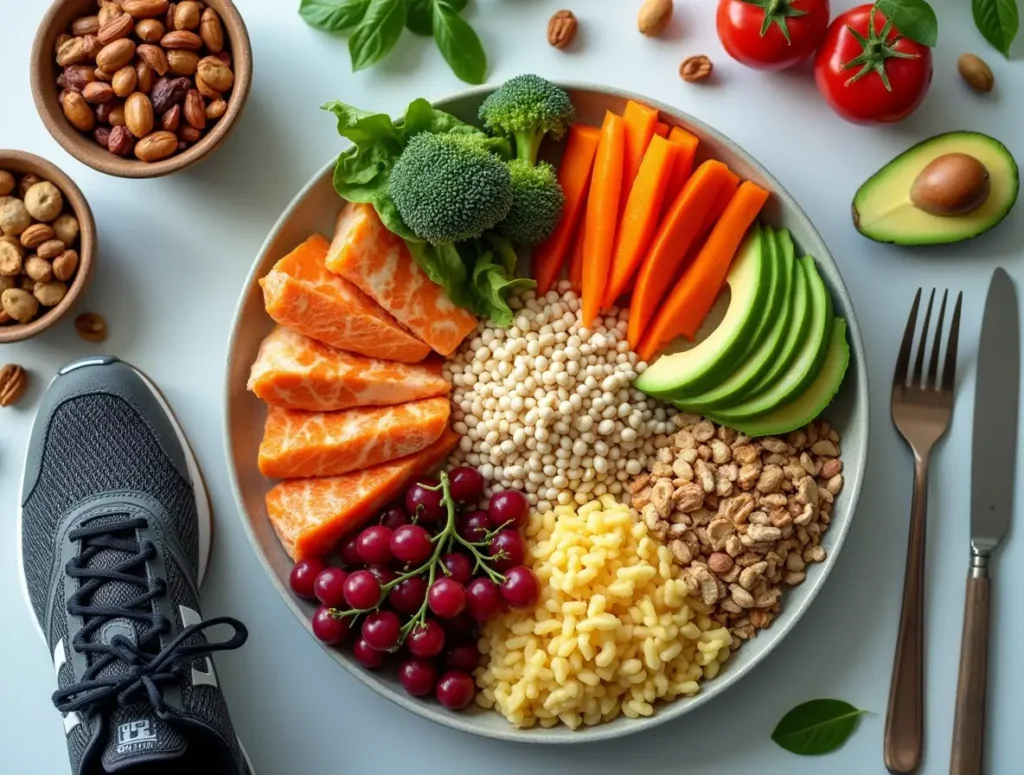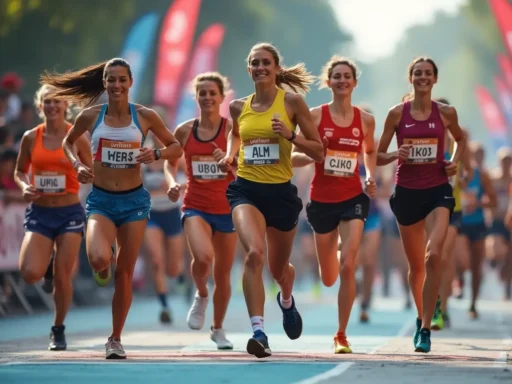Are you getting ready for a 10k run and wondering how many miles is in 10k? It’s 6.2 miles, a challenging but achievable distance. Knowing the 10k distance is key to preparing and reaching your goals. Whether you’re new to running or have experience, understanding the distance and what to expect is crucial. Remember, how many miles is in 10k is essential knowledge for all runners.

For beginners, a 10k race might seem tough. But with a good training plan, you can improve your endurance and confidence. Beginners usually finish a 10k in 50 to 70 minutes, aiming for a 10-minute mile pace. As you train, focus on building endurance, increasing speed, and learning to pace yourself for the 6.2-mile race. Knowing how many miles is in 10k will help you pace yourself effectively.
Table of Contents
Understanding how many miles is in 10k: Miles vs. Kilometers
When you’re getting ready for a 10K run, knowing how many miles is in 10k is key. The “k” in 10K stands for kilometers. Since 1 kilometer is about 0.6 miles, we can figure out the miles in a 10K. We use the formula: Miles = Kilometers × 0.621371. So, for a 10K, it’s 10 kilometers × 0.621371 = 6.21371 miles. To simplify, a 10K is roughly 6.2 miles.
The 10k distance is a big deal in the running world. Many runners aim to finish it as a major achievement. Knowing the exact mile conversion and why the 10K is so popular helps runners get ready. Understanding how many miles is in 10k is an integral part of this knowledge.
The Exact Mile Conversion
A how many miles is in 10k is about 6.21 miles. This is important for runners who measure distances in miles. Knowing this helps them plan their training and get ready for the race. Familiarity with how many miles is in 10k ensures better preparation.
Why the 10K Distance Became Popular
The 10K distance is loved because it’s tough but doable. Runners see it as a way to test their endurance and speed. Plus, talking about how many miles is in a 10K is a big topic among runners.
Understanding how many miles is in 10k can motivate you during training.
| Distance | Miles | Kilometers |
|---|---|---|
| 5K | 3.1 | 5 |
| 10K | 6.2 | 10 |
| Half Marathon | 13.1 | 21.1 |
For clarity, how many miles is in 10k is a fundamental understanding for every runner.
It’s essential to remember that how many miles is in 10k will affect your pacing strategy.
How Many Miles is in 10K: The Simple Answer
To figure out how many miles is in a 10k, we need to know how kilometers and miles relate. One kilometer is about 0.62137 miles. So, 10 kilometers is roughly 6.2137 miles. For easier math, we often say a 10K is about 6.2 miles.
Getting ready for a 10K means knowing the distance and what it takes. A How many miles is in 10k is 6.2 miles long, which is twice the 5K’s 3.1 miles. Here are some distances and their miles:
- 5K: 3.1 miles
- 10K: 6.2 miles
- 15K: 9.3 miles
- Half marathon: 13.1 miles
- Full marathon: 26.2 miles
Knowing the distance and how many miles is in a 10k is key for a good training plan. Beginners should train for 2 to 3 months for a 10K. Most runners finish in over an hour. Knowing how many miles is in a 10k helps you prepare and reach your goals.
Benefits of Running a 10K Race
Running a 10K race offers many benefits. It improves your heart health, boosts stamina, and lifts your mood. It also helps reduce stress and anxiety and improves sleep.
Some key benefits include:
- Improved cardiovascular health
- Increased muscle strength and bone density
- Weight management and improved body composition
- Enhanced mood and reduced stress and anxiety
- Improved sleep quality
Running a 10K regularly can also strengthen your immune system. It lowers the risk of heart disease, diabetes, and some cancers. For most, finishing a 10K in 50 to 70 minutes is within reach.
| Age Group | Men’s Average Finishing Time | Women’s Average Finishing Time |
|---|---|---|
| 16-19 | 46:36 | 1:00:21 |
| 20-24 | 51:40 | 59:50 |
| 25-29 | 53:31 | 1:02:25 |
In summary, running a 10K is great for your health and mood. It also gives you a sense of achievement and connects you with others.
Essential Gear for 10K Training
Having the right gear is key for 10K training. It can boost your performance and make training more enjoyable. Invest in 10k training gear, especially running shoes that support and comfort your feet.
A good pair of running shoes helps prevent injuries and makes running more efficient. Choose shoes made for long distances with enough cushioning and arch support. Also, wear running clothes that wick away moisture to stay dry and comfy.
Other must-haves for 10K training include:
- A water bottle or hydration belt to stay hydrated during long runs
- Cozy socks designed to minimize the chances of blisters and discomfort.
- A running watch or fitness tracker to monitor your progress and pace
It’s crucial to test your gear during training. Make sure you’re comfortable and familiar with it. This means wearing your running shoes and clothes on long runs and practicing with your hydration belt or water bottle.
| Gear | Description |
|---|---|
| Running Shoes | Provide support and comfort during long runs |
| Running Clothes | Moisture-wicking fabrics to keep you dry and comfortable |
| Water Bottle or Hydration Belt | Stay hydrated during long runs |
Investing in the right 10k training gear improves your performance and safety. It also makes your training more enjoyable.

Building Your Base Fitness for a 10K
To start building your base fitness for a 10K, focus on running stamina and endurance. Slowly elevate your running distance and intensity as time progresses. A good 10k training plan is key to moving from beginner to confident runner.
Adding strength exercises to your 10k training plan boosts fitness and lowers injury risk. Start by running 5Ks more often and then increase distance and intensity. This builds the endurance needed for a 10K race.
Starting from Zero
If you’re new to running, start with a walk-run program. Gradually increase your running distance and intensity. This method builds endurance and reduces injury risk. A typical program for beginners includes 6 to 8 weeks of walk-run, followed by 12 weeks to reach 5K, and another 12 weeks for 10K training.
Progressive Training Plans
A progressive 10k training plan mixes running, cross-training, and rest days. This prevents plateaus and overtraining. Cross-training like cycling, swimming, or strength training boosts fitness and lowers injury risk. Increase weekly mileage by 10-15% each week, repeating the same mileage for one to two weeks before increasing again.
| Training Week | Monday | Tuesday | Wednesday | Thursday | Friday | Saturday | Sunday |
|---|---|---|---|---|---|---|---|
| Week 1 | Rest | 3 miles easy run | Rest | 3 miles easy run | Rest | 5 miles long run | Rest |
| Week 2 | Rest | 3.5 miles easy run | Rest | 3.5 miles easy run | Rest | 6 miles long run | Rest |
Finally, remember that how many miles is in 10k should guide your race day preparation strategies.
By following a structured 10k training plan and adding strength exercises, you can improve your running. Listen to your body and adjust your plan as needed to avoid injury and succeed in your 10K race.
Nutrition Strategies for 10K run
A well-balanced diet is key for 10K run. It should include complex carbs, lean protein, and healthy fats. Research shows that eating up to 6g/kg body mass of carbs the day before can boost performance. Also, staying hydrated is vital, as losing just 2% body weight can hurt your performance.
Here are some important tips for 10k nutrition and hydration:
- Start carbohydrate loading 24 hours before the event to build up glycogen stores.
- Choose low-fiber, easy-to-digest foods for pre-race meals to avoid stomach issues.
- Drink enough fluids to replace lost salts from sweating to aid in rehydration.
After the race, eating 20-25g of whey protein can help recover muscle glycogen stores. Opt for high-glycaemic index carbs to quickly refill muscle glycogen. By following these tips, you can improve your performance and reach your goals.
Common 10K Training Mistakes to Avoid
Starting your 10K training journey? It’s key to know common mistakes that can slow you down or hurt you. One big 10K training mistake is overtraining. It can make you feel burnt out and perform worse. Make sure to include rest days and mix in other activities to avoid this.
A good training plan should have running, other workouts, and rest days. For instance, a week might have 3-4 running days, 1-2 days of other activities, and 1-2 rest days. This mix helps you avoid overtraining and keeps you safe from injuries.
Common Mistakes to Watch Out For
- Insufficient rest and recovery time
- Inadequate nutrition and hydration
- Poor pacing and lack of speed work
- Ignoring injury warning signs
By knowing these common 10K training mistakes and how to dodge them, you can have a safe and effective training. Always listen to your body and tweak your plan if needed. This way, you can avoid overtraining and stay on course to meet your 10K goals.
| Mistake | Consequence | Prevention |
|---|---|---|
| Overtraining | Burnout, injury, decreased performance | Incorporate rest days, cross-training, and balanced nutrition |
| Poor pacing | Decreased performance, increased risk of injury | Incorporate speed work and pace management into training plan |
Race Day Preparation Tips
As you get ready for your 10k race, preparation is everything. Arriving early lets you get to know the course and pick up your bib. It also helps you settle in before the race starts. Make sure to wear comfy clothes and have a plan for staying hydrated and fueled.
For hydration, aim for no more than 250ml of water during the race. But, this can change based on the weather. For nutrition, just one energy gel is enough for a 10k. Also, do a 15-minute warm-up to prepare your body.
Here are some more tips for your 10k race day:
- Stick to your target pace using a GPS or running watch to avoid burnout
- Stay focused and motivated with mental preparation techniques such as visualization and positive self-talk
- Have a plan for post-race recovery, including walking around for 30 minutes to aid muscle recovery
By following these tips, you’ll be ready to perform your best. Stay hydrated, fueled, and focused. You’ll have a great time finishing your 10k race.
| Pre-Race | During Race | Post-Race |
|---|---|---|
| Arrive early, wear comfortable clothing | Stay hydrated, fueled, and focused | Walk around for 30 minutes to aid recovery |
Understanding 10K Race Pace
To reach your goals in a 10K race, knowing your pace is key. You need to think about your training, goals, and the race course. A good pace plan helps you stay focused and avoid mistakes like starting too fast or slow.
Many runners use a strategy called negative splitting. This means running the first half slower than the second. For instance, aiming for a 60-minute finish, you might run the first 5 kilometers in 32 minutes and the second in 28. This approach helps you reach your target pace without getting tired too soon.

When figuring out your target pace, consider a few things:
- Your current fitness level and training progress
- The course terrain and elevation changes
- Your goals, whether it’s to finish in a certain time or to achieve a personal best
By understanding these factors and planning your pace, you can improve your 10k performance. This way, you’ll be well-prepared to meet your race goals.
Weather Considerations for Your 10K
When you’re getting ready for your 10K race, think about the 10k weather that might affect you. Running in heat is tough, so it’s key to stay hydrated and cool. Always check the weather forecast before the race to get ready for anything.
Drinking 6 to 8 ounces of water every 15 minutes is crucial when running in heat. You can also use misting stations at certain miles to cool off. Wearing light, breathable clothes and using SPF 50 or higher sunscreen also helps protect your skin from the sun.
When you’re getting ready for your 10K race, think about the 10k weather that might affect you. Running in heat is tough, so it’s key to stay hydrated and cool. Always check the weather forecast before the race to get ready for anything. Understanding how many miles is in 10k will help you plan your hydration accordingly.
- Check the weather forecast before the race to plan your attire and hydration strategy
- Stay hydrated by drinking 6 to 8 ounces of fluid every 15 minutes
- Use misting stations to cool down during the race
- Wear light, breathable clothing and apply sunscreen to protect your skin
Incorporating knowledge of how many miles is in 10k will lead to more effective recovery methods post-race.
Being ready for 10k weather conditions helps you have a safe and successful race. If you’ve had heatstroke or illness before, talk to a doctor before running in heat. With the right prep and plan, you can beat the 10k weather challenges and reach your goals.
Recovery Methods After Your 10K
After running a 10K, it’s crucial to focus on 10k recovery. A good post-race care plan can greatly help your body heal. This plan should cover immediate care like stretching and hydration, and also a long-term plan for rest, nutrition, and cross-training.
Replenishing energy and repairing muscles are key to 10k recovery. Eating a balanced meal with protein and carbs within 30 minutes to 2 hours after the race helps. Drinking water and electrolyte-rich fluids also prevents dehydration and aids recovery.
Immediate Post-Race Care
In the first hour, aim to eat 15-30 grams of protein and 30-120 grams of carbs for muscle recovery. Drinking water and electrolyte-rich fluids is vital to replace lost fluids and electrolytes. Tools like foam rollers and compression clothing can also help with muscle recovery and soreness.
Long-Term Recovery Planning
A long-term plan should include rest, nutrition, and cross-training. This can include light cross-training, stretching, and short runs for the first two weeks. Getting 8-9 hours of sleep each night is also key for recovery and rebuilding.
By following a structured 10k recovery plan, you can recover from the race and be ready for your next event. Remember to prioritize post-race care and give your body the time and rest it needs.
Setting Realistic 10K Time Goals
When setting realistic goals for your 10K run, think about your age, sex, and training level. The average time for men to finish a 10K is about 58 minutes. Women usually take around 1 hour and 6 minutes. Look at average times for your age group to set 10K time goals you can reach.
For example, men aged 20-24 finish in about 51:40. Women in the same age group finish in about 59:50. A good way to find your realistic goals is to look at your past running times and how far you’ve come. If you’re new to running, start with a modest goal and aim to increase it as you get better.
Use online tools, like running pace calculators, to help set a goal. The goal is to make your 10K time goals challenging but reachable. This will keep you motivated and focused during your training.
Here are some general guidelines for 10K time goals based on age and sex:
- Men: 45-50 minutes (competitive), 55-60 minutes (recreational)
- Women: 55-60 minutes (competitive), 65-70 minutes (recreational)
Remember, these are just general guidelines. Your 10K time goals should reflect your own running abilities and progress.
Mental Preparation Techniques
Getting ready for your 10K race means focusing on your 10k mental preparation. It’s about staying motivated and focused, even when things get tough. A great way to do this is through visualization. Imagine yourself crossing the finish line and reaching your goals.
Using visualization helps build your confidence and mental strength. It lets you overcome hard moments in the race. Also, positive self-talk keeps you motivated and focused, helping you do your best.
Here are some important mental preparation tips to remember:
- Break the race into smaller parts
- Keep an eye on your breathing and pace
- Use positive self-talk to stay motivated
By adding these strategies to your 10k mental preparation plan, you’ll see better results. Stay focused, motivated, and positive. Then, you’ll be crossing that finish line in no time.
Track Your Progress: Training Logs and Apps
Starting your 10K journey means tracking your progress. This helps keep you motivated and informed. Using 10k training logs is a great way to monitor your performance and find areas to improve. You’ll see how far you’ve come and can adjust your training plan as needed.
Digital tools like mobile apps can make training better. These apps sync your data for detailed analysis. You can track your daily runs, pace, and heart rate. Apps like Runkeeper, Strava, and Nike Run Club offer personalized plans, audio workouts, and connect with fitness trackers.
As you reflect on your journey, how many miles is in 10k remains a vital takeaway for future races.
Using 10k training logs and apps has many benefits:
- They help you train more efficiently by tracking important metrics.
- You get clear proof of your progress, which you can check weekly, monthly, and yearly.
- They let you compare how different things like weather and terrain affect your runs.
- They make you more accountable, which can motivate you to train more regularly.
These tools can help you improve your training and reach your 10K goal. Stay consistent, track your progress, and adjust your training as needed. This way, your training will be successful and enjoyable.
Conclusion: Your Path to 10K run
You now have the knowledge and tools to conquer your 10K race goals. Focus on proper training, nutrition, and mental preparation. This will help you have a rewarding 10K experience.
Consistent training is crucial for building endurance and strength. Gradually increase your mileage and add cross-training to boost your fitness. Proper fueling and hydration are also key for energy and recovery.
The mental aspect is just as important. Use visualization, positive self-talk, and race-day strategies to stay focused and motivated. Celebrate your progress and don’t get discouraged by setbacks.
With dedication and the right mindset, you can achieve your 10K goals. Enjoy the sense of accomplishment when you cross that finish line. Lace up your shoes, put in the work, and conquer your next 10K race. Your journey to 10K run begins now.
FAQ
How many miles is in a 10K run?
A 10K run is equivalent to 6.2 miles.
Why did the 10K distance become popular?
The 10K distance is a favorite in the running world. Many runners see it as a big achievement. It’s a good challenge for both new and seasoned runners.
What are the benefits of running a 10K race?
Running a 10K can boost your heart health and stamina. It also improves your mental state. Plus, joining a 10K event connects you with others, boosting your motivation.
What essential gear is needed for 10K training and racing?
You’ll need good running shoes and comfy clothes. Don’t forget water bottles and headphones. These items can greatly improve your performance and enjoyment.
How can I build my base fitness for a 10K?
Start by slowly increasing your running endurance. Use progressive training plans. Also, try strength exercises and other cardio activities to boost your fitness.
What are some common 10K training mistakes to avoid?
Avoid overtraining, poor pace management, and neglecting recovery. Rest days and cross-training are key to preventing overtraining.
How can I set realistic 10K time goals?
Consider your age, sex, and training level when setting goals. Choose goals that are challenging yet achievable. This will keep you motivated and focused.
How can I track my progress during 10K training?
Use training logs and apps to track your progress. These tools help you see how you’re doing, find areas to improve, and stay motivated.





Comments are closed.